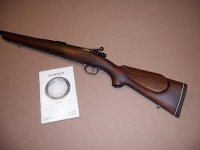Lucky Shooter A
New member
1) Can anyone recommend a good solid indicator holder and base for the outboard indicator when chambering through the head stock ?
2) I'm going to use a faceplate spider to chamber a pretty short barrel-----too short to use the chuck. I have concerns about the four spider screws holding the barrel when turning, threading and reaming. Don't want to get off into "how tight is finger tight" but could use some advice about how tight the spider screws should be. Any thought on this ?
Thanks for any help.
A. Weldy
2) I'm going to use a faceplate spider to chamber a pretty short barrel-----too short to use the chuck. I have concerns about the four spider screws holding the barrel when turning, threading and reaming. Don't want to get off into "how tight is finger tight" but could use some advice about how tight the spider screws should be. Any thought on this ?
Thanks for any help.
A. Weldy



